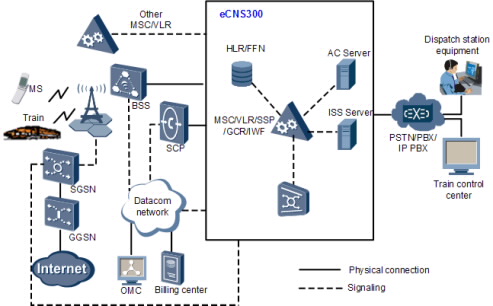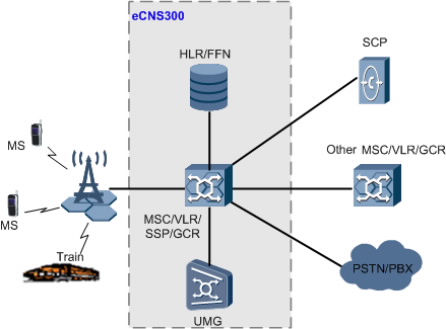Railway-oriented Communication
The eCNS300 solution customizes the HLR, MSC server, and MGW for GSM-R (railway—oriented communication) whose maximum number of subscribers is often smaller than 100 thousand. In this case, the HLR, MSC server, and MGW can be deployed together to meet requirements on the railway-oriented communication.
Improved Reliability
The HLR and MSC server use the high-reliability ATCA hardware platform, which improves reliability when a single NE is working. In addition, the HLR, MSC server, and MGW being deployed in the same cabinet improves system reliability because hardware equipment and resources used for network transmission are reduced.
Improved Performance
The HLR and MSC server use the high-performance ATCA hardware platform, which is an improvement in processing capability compared with the Compact Peripheral Component Interconnect (CPCI) platform.
Easier Maintenance
Core NEs are deployed in the same cabinet, which reduces the number of nodes between NEs on the network and hardware equipment. In addition, the eCNS300 solution improves network management and maintenance with fewer OPEX because it only provides four NE deployment models.
Upgrade to the Long Term Evolution (LTE)
The ATCA hardware platform supports a upgrade to the LTE. In the future, carriers can replace the hardware module and upgrade the software to implement the LTE without more investment.

Four NE Deployment Models
At present, the eCNS300 solution provides four NE deployment models:
| NE Deployment Model
|
Description
|
| Two cabinets (the MSC server, HLR, and MGW)
|
The MSC server and HLR are deployed in the same cabinet and each occupies a subrack.
NOTE
A single cabinet (housing the HLR, MSC server, and MGW) supports a maximum of 300 thousand subscribers and 120 CSD channels. Therefore, it can meet most railway operation requirements.
|
| Single cabinet (the MSC server, HLR, and MGW)
|
The MSC server, HLR, and MGW are deployed in the same cabinet.
|
| Two cabinets (the MSC server and MGW)
|
The MSC server and MGW are deployed in different cabinets.
NOTE
Each NE is independently deployed in the cabinet.
|
| Single cabinet (the MSC server and MGW)
|
The MSC server and MGW are deployed in the same cabinet and the MSC server is placed in one subrack.
NOTE
Each NE is independently deployed in the cabinet.
|
Typical Networking Topology

Typical Networking Topology
The eCNS300 solution supports Customized Applications for Mobile network Enhanced Logic (CAMEL) 4 and CAMEL3, and is backward compatible with the functions of CAMEL2 and CAMEL1. It provides various intelligent network (IN) services in a fast and easy manner on the GSM-R network after being integrated with the TELLIN IN network.


























